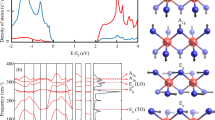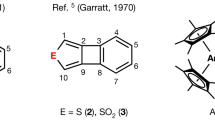Abstract
THE infrared and Raman spectral analysis of Ti(NMe2)4 reported by Bürger et al.1 prompts us to disclose some of our infrared data on a number of dialkylamido derivatives of transition metals2. Of particular interest are the stretching frequencies of the metal–nitrogen bonds. All the compounds examined had a characteristic strong band in the 590–700 cm−1 region (Table 1) which was absent in the parent amine and which we believe is predominantly metal–nitrogen stretching in character. For the tetrakisdialkylamido–metal (IV) compounds, assuming local Td symmetry of the MN4 system, an infrared active band (ν3) should occur involving the asymmetric metal–nitrogen stretching vibration and it is suggested that this corresponds to the “characteristic band” shown in Table 1 although it is recognized that coupling with other modes of vibration may be involved. The work of Bürger et al.1 confirms our assignment in the case of Ti(NMe2)4. Considering the titanium, zirconium, hafnium compounds M(NR2)4, it is interesting to note the definite increase in frequency with increase in chain length of the alkyl group R. This is interpreted as indicative of a significant degree of ligand→metal π-electron donation  involving the lone-pair of electrons on nitrogen and the vacant d-orbitals on the metal. Other factors such as the mass-effect of the ligand or its steric effect would lead to a decrease in frequency with increase in size of the alkyl groups contrary to the observed results.
involving the lone-pair of electrons on nitrogen and the vacant d-orbitals on the metal. Other factors such as the mass-effect of the ligand or its steric effect would lead to a decrease in frequency with increase in size of the alkyl groups contrary to the observed results. 
This is a preview of subscription content, access via your institution
Access options
Subscribe to this journal
Receive 51 print issues and online access
$199.00 per year
only $3.90 per issue
Buy this article
- Purchase on Springer Link
- Instant access to full article PDF
Prices may be subject to local taxes which are calculated during checkout
Similar content being viewed by others
References
Bürger, H., Stammreich, H., and Sans, Th. T., Monatshefte Chemie, 97, 1276 (1966).
Gitlitz, M. H., thesis, Univ. Western Ontario (1965).
Bradley, D. C., and Thomas, I. M., Canad. J. Chem., 40, 449 (1962).
Bradley, D. C., and Thomas, I. M., Canad. J. Chem., 40, 1355 (1962).
Author information
Authors and Affiliations
Rights and permissions
About this article
Cite this article
BRADLEY, D., GITLITZ, M. Metal–Nitrogen Infrared Stretching Frequencies in Dialkylamido-transition Metal Compounds. Nature 218, 353–354 (1968). https://doi.org/10.1038/218353b0
Received:
Issue Date:
DOI: https://doi.org/10.1038/218353b0
Comments
By submitting a comment you agree to abide by our Terms and Community Guidelines. If you find something abusive or that does not comply with our terms or guidelines please flag it as inappropriate.



